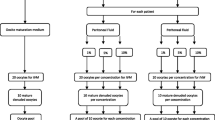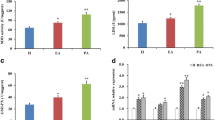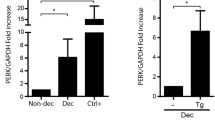Abstract
The oviduct is a site for early reproductive events including gamete maturation, fertilization, and early embryo development. Secretory cells lining the oviduct lumen synthesize and secrete proteins that interact with gametes and developing embryos. Although previous studies have identified some of the secretory proteins in the oviduct, however, knowledge and their precise specific functions in the oviduct are poorly understood. In this study, by using proteomic approach, we identified a secretory protein, Peroxiredoxin 6 (PRDX6), and evaluated its role in mediating early pregnancy events, fertilization, and embryo development in rabbit oviduct. The expression of PRDX6 was significantly higher in ampulla and isthmus sections of the oviduct in mated animal groups compared to non-mated controls. Furthermore, significant reduction in number of embryos recovered from PRDX6 siRNA-transfected oviductal horn was observed compared to the control contralateral horn. Moreover, in animals receiving PRDX6 siRNA in their oviductal horn, the number of implanted blastocysts was significantly less in the uterus as observed on day 9 post-coital (p.c.). Further, during embryo-rabbit oviduct epithelial cell (ROEC) co-culture, siRNA-mediated PRDX6 silencing attenuated the early embryonic development. Mechanistically, increased levels of ROS and expression of oxidative stress- and inflammation-related proteins were found in PRDX6 siRNA-treated ROEC cells as compared to control cells, implicating that ablation of PRDX6 in the oviduct creates a stress-induced micro-environment detrimental to early embryonic development in oviduct. Taken together, our data suggest that PRDX6 maintains an optimal micro-environment conducive to successful embryo development and can be considered as a candidate to evaluate its therapeutic potential in IVF strategies.







Similar content being viewed by others
Availability of Data and Material
Not applicable
Code Availability
Not applicable
Abbreviations
- ROS:
-
Reactive oxygen species
- p.c.:
-
Post-coitum
- ART:
-
Assisted reproductive technology
- IVF:
-
In vitro fertilization
- ROECs:
-
Rabbit oviductal epithelial cells
References
Georgiou AS, Sostaric E, Wong CH, Snijders APL, Wright PC, Moore HD, et al. Gametes alter the oviductal secretory proteome. Mol Cell Proteomics. 2005;4(11):1785–96.
Lee KF, Yeung WS. Gamete/embryo - oviduct interactions: implications on in vitro culture. Hum Fertil (Camb). 2006;9(3):137–43.
Lee KF, Yao YQ, Kwok KL, Xu JS, Yeung WSB. Early developing embryos affect the gene expression patterns in the mouse oviduct. Biochem Biophys Res Commun. 2002;292(2):564–70.
Wolf E, Arnold GJ, Bauersachs S, Beier HM, Blum H, Einspanier R, et al. Embryo-maternal communication in bovine - strategies for deciphering a complex cross-talk. Reprod Domest Anim. 2003;38(4):276–89.
Downing SJ, Maguiness SD, Tay JI, Watson A, Leese HJ. Effect of platelet-activating factor on the electrophysiology of the human Fallopian tube: early mediation of embryo-maternal dialogue? Reproduction. 2002;124(4):523–9.
Xu J, Cheung TM, Chan STH, Ho PC, Yeung WSB. Human oviductal cells reduce the incidence of apoptosis in cocultured mouse embryos. Fertil Steril. 2000;74(6):1215–9.
Xu JS, Cheung TM, Ting-Hon Chan S, Ho PC, Shu-Biu Yeung W. Temporal effect of human oviductal cell and its derived embryotrophic factors on mouse embryo development. Biol Reprod. 2001;65(5):1481–8.
Guerin P, El Mouatassim S, Menezo Y. Oxidative stress and protection against reactive oxygen species in the pre-implantation embryo and its surroundings. Hum Reprod Update. 2001;7(2):175–89.
Bedaiwy MA, Goldberg JM, Falcone T, Singh M, Nelson D, Azab H, et al. Relationship between oxidative stress and embryotoxicity of hydrosalpingeal fluid. Hum Reprod. 2002;17(3):601–4.
Barroso RP, Osuamkpe C, Nagamani M, Yallampalli C. Nitric oxide inhibits development of embryos and implantation in mice. Mol Hum Reprod. 1998;4(5):503–7.
Matsuzuka T, et al. Effects of heat stress on the redox status in the oviduct and early embryonic development in mice. J Reprod Dev. 2005;51(2):281–7.
Sostaric E, Georgiou AS, Wong CH, Watson PF, Holt WV, Fazeli A. Global profiling of surface plasma membrane proteome of oviductal epithelial cells. J Proteome Res. 2006;5(11):3029–37.
Pillai VV, Weber DM, Phinney BS, Selvaraj V. Profiling of proteins secreted in the bovine oviduct reveals diverse functions of this luminal microenvironment. PLoS One. 2017;12(11):e0188105.
Castaldo SA, et al. The tumorigenic roles of the cellular REDOX regulatory systems. Oxidative Med Cell Longev. 2016;2016:8413032.
Kim SY, Jo HY, Kim MH, Cha YY, Choi SW, Shim JH, et al. H2O2-dependent hyperoxidation of peroxiredoxin 6 (Prdx6) plays a role in cellular toxicity via up-regulation of iPLA2 activity. J Biol Chem. 2008;283(48):33563–8.
Leyens G, Verhaeghe B, Landtmeters M, Marchandise J̈, Knoops B, Donnay I. Peroxiredoxin 6 is upregulated in bovine oocytes and cumulus cells during in vitro maturation: role of intercellular communication. Biol Reprod. 2004;71(5):1646–51.
Leyens G, Knoops B, Donnay I. Expression of peroxiredoxins in bovine oocytes and embryos produced in vitro. Mol Reprod Dev. 2004;69(3):243–51.
Tamura H, Takasaki A, Miwa I, Taniguchi K, Maekawa R, Asada H, et al. Oxidative stress impairs oocyte quality and melatonin protects oocytes from free radical damage and improves fertilization rate. J Pineal Res. 2008;44(3):280–7.
Hirota Y, Acar N, Tranguch S, Burnum KE, Xie H, Kodama A, et al. Uterine FK506-binding protein 52 (FKBP52)-peroxiredoxin-6 (PRDX6) signaling protects pregnancy from overt oxidative stress. Proc Natl Acad Sci U S A. 2010;107(35):15577–82.
Arora M, Jaroudi KA, Hamilton CJCM, Dayel F. Controlled comparison of interceed and amniotic membrane graft in the prevention of postoperative adhesions in the rabbit uterine horn model. Eur J Obstet Gynecol Reprod Biol. 1994;55(3):179–82.
Dutta S, Sengupta P. Rabbits and men: relating their ages. J Basic Clin Physiol Pharmacol. 2018;29(5):427–35.
Manohar M, Khan H, Sirohi VK, Das V, Agarwal A, Pandey A, et al. Alteration in endometrial proteins during early- and mid-secretory phases of the cycle in women with unexplained infertility. PLoS One. 2014;9(11):e111687.
Agrawal S, Singh A, Tripathi P, Mishra M, Singh PK, Singh MP. Cypermethrin-induced nigrostriatal dopaminergic neurodegeneration alters the mitochondrial function: a proteomics study. Mol Neurobiol. 2015;51(2):448–65.
Sinha A, Srivastava N, Singh S, Singh AK, Bhushan S, Shukla R, et al. Identification of differentially displayed proteins in cerebrospinal fluid of Parkinson’s disease patients: a proteomic approach. Clin Chim Acta. 2009;400(1-2):14–20.
Kapoor I, Kanaujiya J, Kumar Y, Thota JR, Bhatt MLB, Chattopadhyay N, et al. Proteomic discovery of MNT as a novel interacting partner of E3 ubiquitin ligase E6AP and a key mediator of myeloid differentiation. Oncotarget. 2016;7(7):7640–56.
Popli P, Sirohi VK, Manohar M, Shukla V, Kaushal JB, Gupta K, et al. Regulation of cyclooxygenase-2 expression in rat oviductal epithelial cells: evidence for involvement of GPR30/Src kinase-mediated EGFR signaling. J Steroid Biochem Mol Biol. 2015;154:130–41.
Lessey BA, Castelbaum AJ, Sawin SW, Sun J. Integrins as markers of uterine receptivity in women with primary unexplained infertility. Fertil Steril. 1995;63(3):535–42.
Baranda-Avila N, Cardoso-Rangel ME, Cerbón M, Camacho-Arroyo I, Mendoza-Rodríguez CA, Villaseñor-Gaona H, et al. Differential expression of estrogen receptor alpha gene in the ampullae and isthmus regions of the rabbit oviduct during early pregnancy. Anim Reprod Sci. 2010;121(3-4):286–93.
Carney EW, Tobback C, Ellington JE, Foote RH. Co-culture of rabbit 2-cell embryos with rabbit oviduct epithelial cells and other somatic cells. Mol Reprod Dev. 1990;27(3):209–15.
Cheong AW, et al. Oviductal microsomal epoxide hydrolase (EPHX1) reduces reactive oxygen species (ROS) level and enhances preimplantation mouse embryo development. Biol Reprod. 2009;81(1):126–32.
Carney EW, Tobback C, Foote RH. Co-culture of rabbit one-cell embryos with rabbit oviduct epithelial cells. In Vitro Cell Dev Biol. 1990;26(6):629–35.
Kaneko Y, Day ML, Murphy CR. Integrin beta3 in rat blastocysts and epithelial cells is essential for implantation in vitro: studies with Ishikawa cells and small interfering RNA transfection. Hum Reprod. 2011;26(7):1665–74.
Lee YL, Lee KF, Xu JS, Kwok KL, Luk JM, Lee WM, et al. Embryotrophic factor-3 from human oviductal cells affects the messenger RNA expression of mouse blastocyst. Biol Reprod. 2003;68(2):375–82.
Zumoffen CM, Gil R, Caille AM, Morente C, Munuce MJ, Ghersevich SA. A protein isolated from human oviductal tissue in vitro secretion, identified as human lactoferrin, interacts with spermatozoa and oocytes and modulates gamete interaction. Hum Reprod. 2013;28(5):1297–308.
Fatma N, Singh P, Chhunchha B, Kubo E, Shinohara T, Bhargavan B, et al. Deficiency of Prdx6 in lens epithelial cells induces ER stress response-mediated impaired homeostasis and apoptosis. Am J Phys Cell Phys. 2011;301(4):C954–67.
Zhang XZ, Xiao ZF, Li C, Xiao ZQ, Yang F, Li DJ, et al. Triosephosphate isomerase and peroxiredoxin 6, two novel serum markers for human lung squamous cell carcinoma. Cancer Sci. 2009;100(12):2396–401.
Menezo Y, Guerin P, Elder K. The oviduct: a neglected organ due for re-assessment in IVF. Reprod BioMed Online. 2015;30(3):233–40.
Lobo MV, et al. Immunohistochemical localization of taurine in the rat ovary, oviduct, and uterus. J Histochem Cytochem. 2001;49(9):1133–42.
Lapointe J, Bilodeau JF. Antioxidant defenses are modulated in the cow oviduct during the estrous cycle. Biol Reprod. 2003;68(4):1157–64.
El Mouatassim S, Guerin P, Menezo Y. Mammalian oviduct and protection against free oxygen radicals: expression of genes encoding antioxidant enzymes in human and mouse. Eur J Obstet Gynecol Reprod Biol. 2000;89(1):1–6.
Kim SY, Chun E, Lee KY. Phospholipase A(2) of peroxiredoxin 6 has a critical role in tumor necrosis factor-induced apoptosis. Cell Death Differ. 2011;18(10):1573–83.
Das S, Chattopadhyay R, Ghosh S, Ghosh S, Goswami SK, Chakravarty BN, et al. Reactive oxygen species level in follicular fluid—embryo quality marker in IVF? Hum Reprod. 2006;21(9):2403–7.
Aitken RJ. Impact of oxidative stress on male and female germ cells: implications for fertility. Reproduction. 2020;159(4):R189–201.
Agarwal A, Said TM, Bedaiwy MA, Banerjee J, Alvarez JG. Oxidative stress in an assisted reproductive techniques setting. Fertil Steril. 2006;86(3):503–12.
Johnson MH, Nasr-Esfahani MH. Radical solutions and cultural problems: could free oxygen radicals be responsible for the impaired development of preimplantation mammalian embryos in vitro? Bioessays. 1994;16(1):31–8.
Nasr-Esfahani MH, Aitken JR, Johnson MH. Hydrogen peroxide levels in mouse oocytes and early cleavage stage embryos developed in vitro or in vivo. Development. 1990;109(2):501–7.
Goto Y, Noda Y, Mori T, Nakano M. Increased generation of reactive oxygen species in embryos cultured in vitro. Free Radic Biol Med. 1993;15(1):69–75.
Gardiner CS, Salmen JJ, Brandt CJ, Stover SK. Glutathione is present in reproductive tract secretions and improves development of mouse embryos after chemically induced glutathione depletion. Biol Reprod. 1998;59(2):431–6.
Guerin P, Menezo Y. Hypotaurine and taurine in gamete and embryo environments: de novo synthesis via the cysteine sulfinic acid pathway in oviduct cells. Zygote. 1995;3(4):333–43.
Gardiner CS, Reed DJ. Status of glutathione during oxidant-induced oxidative stress in the preimplantation mouse embryo. Biol Reprod. 1994;51(6):1307–14.
Joo BS, Kim MK, Na YJ, Moon HS, Lee KS, Kim HD. The mechanism of action of coculture on embryo development in the mouse model: direct embryo-to-cell contact and the removal of deleterious components. Fertil Steril. 2001;75(1):193–9.
Matsuoka I, Fujino Y, Ogita S, Inoue M. Impact of erythrocytes on mouse embryonal development in vitro. FEBS Lett. 1995;371(3):297–9.
Rossi T, Mazzilli F, Delfino M, Dondero F. Improved human sperm recovery using superoxide dismutase and catalase supplementation in semen cryopreservation procedure. Cell Tissue Bank. 2001;2(1):9–13.
Roca J, Rodríguez MJ, Gil MA, Carvajal G, Garcia EM, Cuello C, et al. Survival and in vitro fertility of boar spermatozoa frozen in the presence of superoxide dismutase and/or catalase. J Androl. 2005;26(1):15–24.
Ng KYB, Cheong Y. Hydrosalpinx - salpingostomy, salpingectomy or tubal occlusion. Best Pract Res Clin Obstet Gynaecol. 2019;59:41–7.
Yohannes E, Kazanjian AA, Lindsay ME, Fujii DT, Ieronimakis N, Chow GE, et al. The human tubal lavage proteome reveals biological processes that may govern the pathology of hydrosalpinx. Sci Rep. 2019;9(1):8980.
Camus E, Poncelet C, Goffinet F, Wainer B, Merlet F, Nisand I, et al. Pregnancy rates after in-vitro fertilization in cases of tubal infertility with and without hydrosalpinx: a meta-analysis of published comparative studies. Hum Reprod. 1999;14(5):1243–9.
Chanr LY, Chiu PY, Lau TK. Hydrosalpinx fluid induced embryotoxicity and lipid peroxidation. Reprod Toxicol. 2004;19(1):147–8.
Acknowledgements
The authors wish to thank Dr. M.P. Singh, Principal Scientist, CSIR-IITR, Lucknow, for his help and valuable suggestions during the study. The authors wish to thank Dr. T.J. Reddy SAIF-facility, CSIR-CDRI, for help in MS/MS analysis. P.P. is recipient of Senior Research Fellowship from the Indian Council of Medical Research, New Delhi. We thank Skyler Hendrix and Anushree Seth for assisting with English language use in association with InPrint, Washington University, St. Louis, MO. The CSIR-CDRI communication number is 10263.
Funding
This work was supported by grants from the CSIR network project “PROGRAM” on “Factors Governing Competent Gamete Production and Reproductive Dysfunction” (BSC0101).
Author information
Authors and Affiliations
Contributions
A.D. conceptualized the study. P.P., V.S., J.B.K., R.K., and K.G. performed the experiments. P.P. and A.D. analyzed the data. P.P. and A.D. wrote the manuscript. All authors have approved the final version of the manuscript.
Corresponding author
Ethics declarations
Ethics Approval
All experimental procedures were performed with the guidelines and protocols approved by the Institutional Animal Ethics Committee for the Use of Laboratory Animals of CSIR-CDRI, Lucknow, India (Approval No.: IAEC/2012/24).
Consent to Participate
Not applicable
Consent for Publication
Not applicable
Conflict of Interest
The authors declare no competing interests.
Additional information
Publisher’s Note
Springer Nature remains neutral with regard to jurisdictional claims in published maps and institutional affiliations.
Supplementary Information
Supplementary Figure S1:
2-D gel electrophoresis (2-D PAGE) between ampullary region of non-mated (control) versus mated rabbit (10.5 h p.c.) (n=3). (A) Representative gel image of 2-D PAGE is shown here. A total of 15 differentially altered protein spots (upregulated or downregulated) were identified by image master 2-D platinum software. (B) The spot volumes of the differentially expressed proteins (up or down) in ampulla of control (non-mated) and mated rabbit is shown as bar diagram in the lower panel. The data are expressed as mean±SE, n=3. P values are ‘b’ (P<0.01) and ‘c’ (P<0.05) versus control (non-mated). (JPG 5637 kb)
Supplementary Figure S2:
Localization of PDI, PP1, TPM1, PRDX6, PAF in ampulla of control (non-mated) and mated rabbits (10.5 h p.c.). Lower panel shows image analysis of PDI, PP1, TPM1, PRDX6, and PAF in ampulla of both groups. The immunostaining intensity of all proteins in the epithelium, stroma, lamina propria and smooth muscle cells were assessed semi-quantitatively on a four-point scale: 0 for no staining, 1 for mild staining, 2 for moderate staining and 3 for intense staining. The histologic score (HSCORE) was calculated as follows: HSCORE =Σ Pi (i + 1), where i=1, 2 or 3, and Pi is the percentage of each intensity, from 0 to 100%. Str (Stroma), GE (glandular epithelium), and LE (luminal epithelium). Magnification 10X, n=6 in all the groups. (JPG 7493 kb)
Supplementary Figure S3:
Rabbit oviductal epithelial cells (ROECs) were characterized by the expression of cytokeratin, an epithelial marker, by immunofluorescence. Primary ROECs were fixed, permeabilized, incubated with cytokeratin antibody for overnight, and incubated with FITC-conjugated anti-mouse antibody for 1 h. The preparations were washed and counterstained with DAPI and cell images were grasped using a Leica fluorescence microscope at 20X. (JPG 1892 kb)
Supplementary Figure S4:
Unfertilized oocytes recovered from scram or PRDX6 siRNA- transfected oviductal horns. (JPG 618 kb)
Supplementary Table S1:
Differentially expressed proteins identified by MS/MS analysis between ampullary regions of non-mated (control) versus mated (10.5 h p.c.) rabbit oviduct. (DOCX 14 kb)
Supplementary Table S2:
Summary of results obtained from proposed study. (DOCX 13 kb)
Rights and permissions
About this article
Cite this article
Popli, P., Shukla, V., Kaushal, J.B. et al. Peroxiredoxin 6 Plays Essential Role in Mediating Fertilization and Early Embryonic Development in Rabbit Oviduct. Reprod. Sci. 29, 1560–1576 (2022). https://doi.org/10.1007/s43032-021-00689-x
Received:
Accepted:
Published:
Issue Date:
DOI: https://doi.org/10.1007/s43032-021-00689-x




